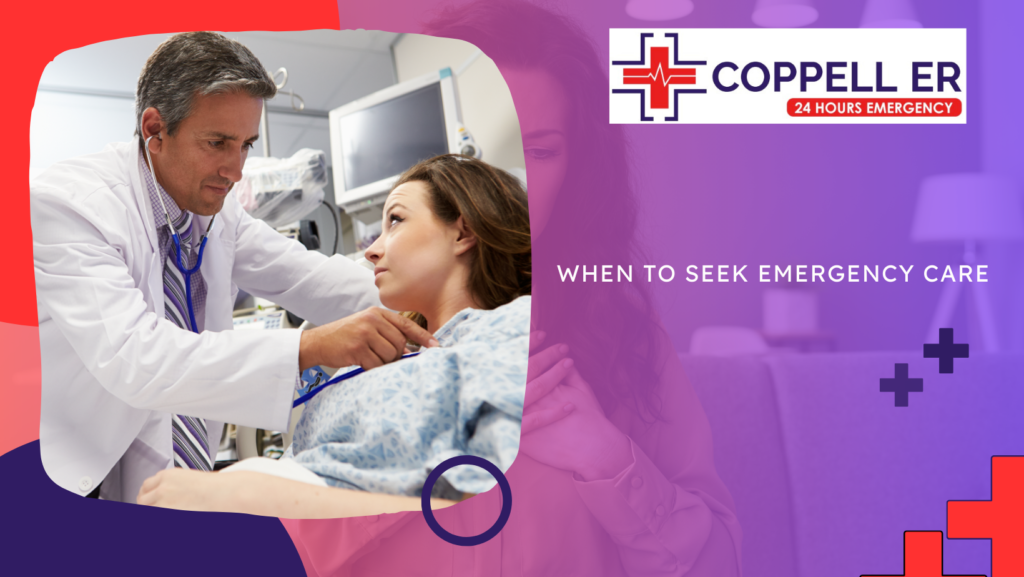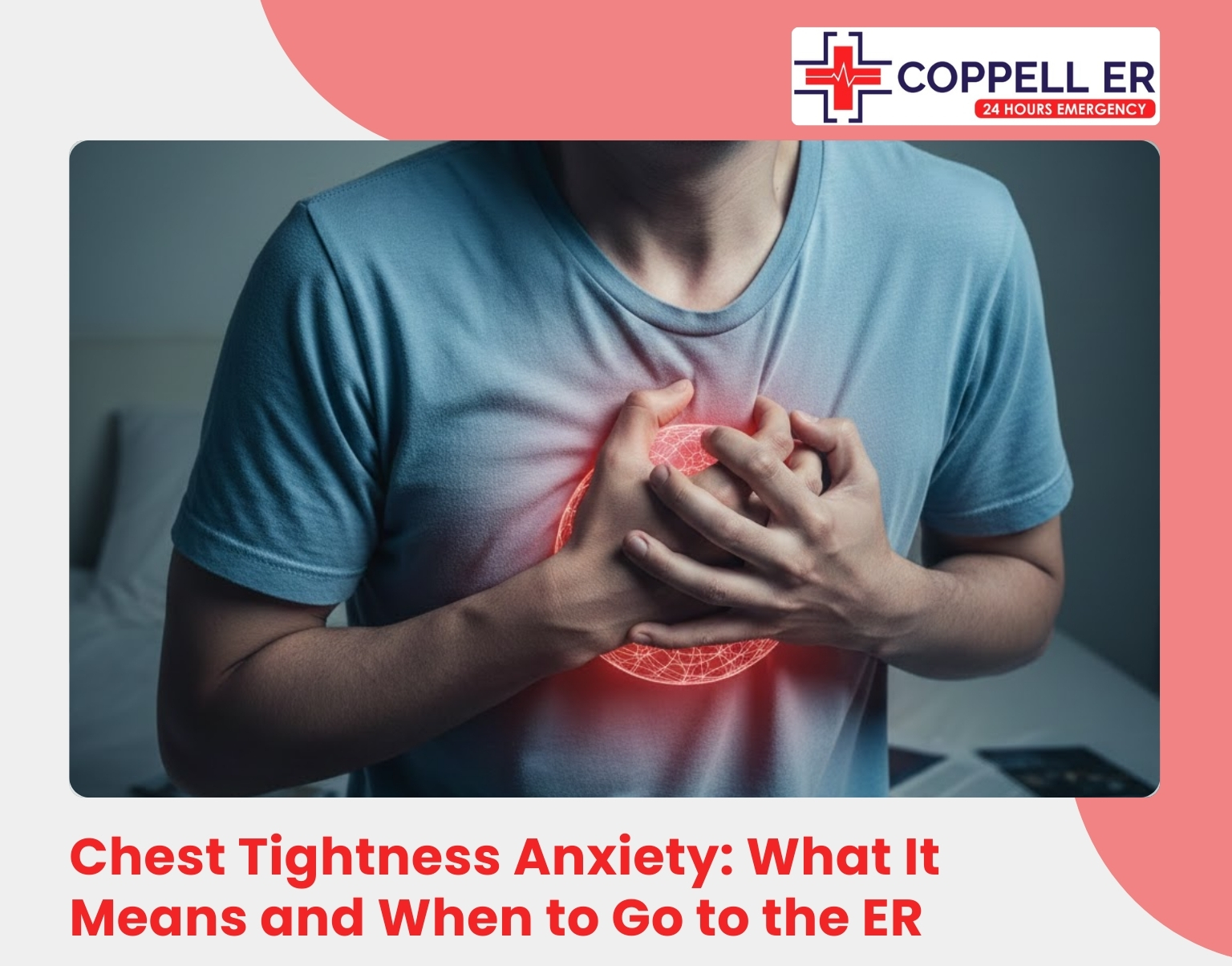Every year, around 7.6 million Americans experience chest pain. Although a lot of chest pain is not dangerous, some types can indicate serious conditions like a heart attack and require quick medical attention.
Treatment for life-threatening conditions like chest pain should not be delayed. If you experience chest pain that lasts more than a few minutes or becomes more severe, immediate action is necessary. Open 24 hours, seven days a week, with highly trained staff, our Coppell Emergency Room provides urgent treatment to save lives.
Understanding chest pain and knowing when to get help can make a huge difference. This guide aims to provide you with a comprehensive understanding of chest pain, its causes, symptoms, and most importantly, when to seek emergency care.
| Check out our emergency care page for more information or immediate help. |
What is Chest Pain?
Chest pain refers to any discomfort or pain you feel along the front of the body, from the neck to the upper abdomen. Various conditions, ranging from minor issues to serious medical problems, can cause it.
Types of Chest Pain
Not all chest pain is created equal. Understanding the different types can help you better assess the situation.
-
Cardiac Chest Pain
Cardiac chest pain, often referred to as angina, occurs when the heart muscle doesn’t get enough oxygen-rich blood. This type of pain is commonly associated with heart-related conditions.
Common Causes of Cardiac Chest Pain
- Heart Attack (Myocardial Infarction): A heart attack occurs when a blockage in one or more of the coronary arteries cuts off the blood flow to the heart muscle. This causes crushing chest pain with symptoms like shortness of breath, sweating, and nausea.
- Angina: Chest pain caused by reduced blood flow to the heart muscle, often due to coronary artery disease. There are two main types:
- Stable Angina: Triggered by physical activity or stress and usually goes away with rest or medication.
- Unstable Angina: Occurs unexpectedly, is more severe, and lasts longer than stable angina. It can be a sign of an impending heart attack.
- Myocarditis: Inflammation of the heart muscle, often caused by viral infections. It can cause chest pain, fatigue, and sometimes heart failure if severe.
- Pericarditis: Inflammation of the pericardium, the sac surrounding the heart. It can cause sharp, stabbing chest pain that may worsen with deep breaths, coughing, or lying down.
- Aortic Dissection: A rare but life-threatening condition where the inner layer of the aorta tears, causing severe chest and back pain.
-
Non-Cardiac Chest Pain
Non-cardiac chest pain is not related to the heart. While it can be unsettling and mimic symptoms of cardiac chest pain, it is usually caused by issues outside the cardiovascular system.
Common Causes of Non-Cardiac Chest Pain
- Gastroesophageal Reflux Disease (GERD): A digestive disorder where stomach acid flows back into the esophagus, causing irritation and a burning sensation in the chest (heartburn).
- Musculoskeletal Conditions: Issues related to the muscles, ribs, or joints in the chest area cause chest pain. Conditions like costochondritis (inflammation of the cartilage that connects the ribs to the breastbone) or muscle strains are common causes.
- Panic Attacks and Anxiety: Intense anxiety or panic attacks cause chest pain with symptoms like rapid heartbeat, shortness of breath, sweating, and a sense of impending doom.
- Lung Conditions: Respiratory problems; pneumonia (lung infection), pleuritis (inflammation of the lining around the lungs), or pulmonary embolism (blockage in the lung arteries) lead to chest pain. It worsens with breathing or coughing.
- Esophageal Disorders: Conditions like esophageal spasms (sudden, intense contractions of the esophagus) or esophageal motility disorders cause chest pain, often related to swallowing or eating.
Characteristics of Chest Pain
| Cardiac Chest Pain | Non-Cardiac Chest Pain | |
| Location | Located in the center of the chest but can also spread to the shoulders, left arm, back, neck, or jaw. | Occurs in the center of the chest and radiates to the back, shoulders, arms, neck, or jaw. |
| Sensation | Pressure, squeezing, fullness, or a heavy weight on the chest. | Sharp, stabbing, burning, or aching. It may feel like pressure or discomfort. |
| Duration | Last for a few minutes or more,
Triggered by physical activity or stress. |
Persist for an extended period,
Not consistently triggered by physical activity or stress. |
Symptoms of Chest Pain
| Cardiac Chest Pain | Non-Cardiac Chest Pain |
| Shortness of breath | Belching or regurgitation (GERD)
|
| Sweating | Tenderness or pain when pressing on the chest (musculoskeletal issues) |
| Nausea or vomiting | Hyperventilation or feelings of impending doom (panic attacks) |
| Dizziness | Cough, fever, or difficulty breathing (lung conditions) |
| Rapid/irregular heartbeat | Difficulty swallowing or pain with swallowing (esophageal disorders) |
| Weakness or fatigue |
When to Seek Emergency Care?

- Sudden, intense chest pain, like pressure, squeezing, or a heavy weight on the chest.
- Chest pain that radiates to the left arm, neck, jaw, or back.
- Chest pain accompanied by sweating, nausea, vomiting, lightheadedness, or shortness of breath.
- Irregular, fast, or pounding heartbeat (palpitations) along with chest pain.
- A history of heart disease, angina, or a previous heart attack with new or worsening chest pain.
- Chest pain following physical trauma, especially to the chest area.
- Persistent chest pain that does not go away, even with rest or medication.
These symptoms could indicate a heart attack or another serious condition that requires immediate medical attention.
Identifying Chest Pain Triggers
Identifying triggers for chest pain can be crucial in managing and preventing future episodes. Here are some common triggers to watch out for:
Physical Activity: Note if chest pain occurs during or after physical exertion. This could indicate angina or other cardiovascular issues.
Emotional Stress: Pay attention to situations that provoke stress or anxiety, as these can lead to chest pain episodes. Techniques like deep breathing, meditation, or counseling may help manage stress-related triggers.
Dietary Factors: Certain foods or beverages trigger chest pain, especially in individuals with conditions like GERD. Spicy, acidic, or fatty foods are common culprits.
Positional Changes: Notice if chest pain worsens or improves with certain body positions, such as lying down, standing up, or bending over. This provides clues to conditions like pericarditis or musculoskeletal issues.
Environmental Factors: Changes in temperature or exposure to allergens or pollutants trigger chest pain, particularly in individuals with respiratory conditions or allergies.
Medications: Some medications cause side effects that include chest pain. If you notice chest discomfort after starting a new medication, consult with a healthcare provider.
Smoking and Alcohol: Tobacco use and heavy alcohol consumption contribute to chest pain, especially in individuals with underlying heart or lung conditions.
Underlying Health Conditions: Certain medical conditions such as asthma, bronchitis, or anxiety disorders also trigger chest pain.
Sleep Patterns: Lack of sleep or irregular sleep patterns sometimes contribute to stress and trigger chest pain in susceptible individuals.
Managing Chest Pain at Home

It’s crucial to consult a healthcare professional for medical advice. However, if chest pain is not severe, you can manage it at home by following these steps to alleviate discomfort:
Rest: Sitting down and resting in a comfortable position reduces strain on the heart and body.
Loosen Clothing: If chest pain is accompanied by tightness or discomfort, loosening tight clothing, especially around the neck and chest, helps.
Take Medications: If you are prescribed medications for chest pain or related conditions (like nitroglycerin for angina), taking them as directed by a healthcare provider is essential.
Gastric Relief: If GERD or heartburn is suspected as the cause of chest pain, avoiding spicy, acidic, or fatty foods provide relief.
Cold Compress: Applying a cold compress or ice pack to the chest area can reduce inflammation and alleviate discomfort, especially if the pain is musculoskeletal.
Conclusion
Chest pain is a symptom that you should always take seriously. Understanding its various causes, symptoms, and the importance of seeking emergency care is life-saving. If you or your loved one is experiencing chest pain, don’t wait to visit our emergency care page for immediate assistance. Your health is too important to delay.
| Request an appointment for expert care and immediate attention |
FAQs
What is the ICD-10 code for chest pain?
The ICD-10 code for chest pain is R07.9.
Can anxiety cause chest pain?
Yes, anxiety can cause chest pain. This type of pain is often associated with panic attacks and includes symptoms like a rapid heartbeat, shortness of breath, and dizziness.
Can dehydration cause chest pain?
Dehydration leads to muscle cramps and discomfort, which sometimes manifest as chest pain. Staying well-hydrated is important for overall health and helps prevent these symptoms.
Will high cholesterol lead to chest pain?
High cholesterol contributes to the buildup of plaques in the arteries. It potentially leads to conditions like angina or heart attacks, which cause chest pain.
What services does Coppell Emergency Room offer for chest pain?
At Coppell Emergency Room, we offer 24/7 comprehensive emergency care services for chest pain, including:
- Rapid assessment and evaluation.
- Diagnostic tests such as electrocardiogram (ECG), blood tests, and imaging studies to determine the cause of chest pain.
- Treatment options tailored to your specific condition, including medications, interventions, or referrals to specialists.
- Continuous monitoring and follow-up care as needed.
References:
McGinn AP, Rosamond WD, Goff DC Jr, Taylor HA, Miles JS, Chambless L. Trends in prehospital delay time and use of emergency medical services for acute myocardial infarction: experience in 4 US communities from 1987-2000. Am Heart J 2005;150:392-400.
- Kainth A, Hewitt A, Sowden A, Duffy S, Pattenden J, Lewin R, et al. Systematic review of interventions to reduce delay in patients with suspected heart attack. Emerg Med J 2004;21:506-8.
- Luepker RV, Raczynski JM, Osganian S, Goldberg RJ, Finnegan JR Jr, Hedges JR, et al. Effect of a community intervention on patient delay and emergency medical service use in acute coronary heart disease: the rapid early action for coronary treatment (REACT) trial. JAMA 2000;284:60-7.




